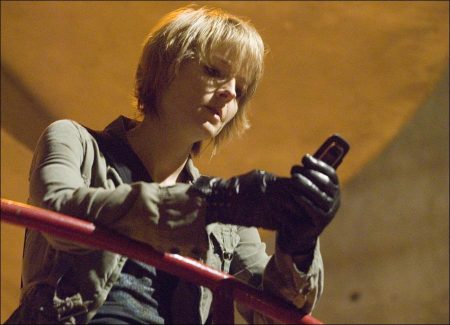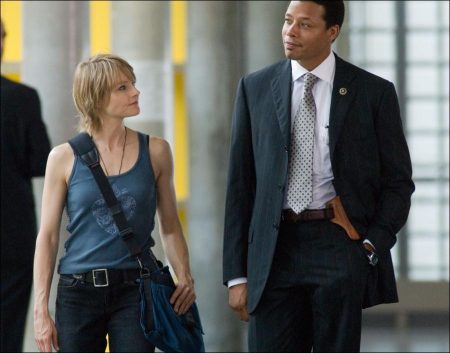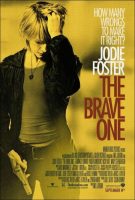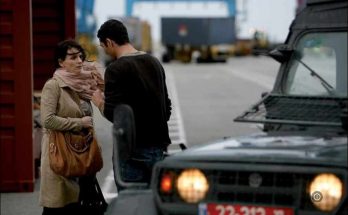Directions on the Moral Compass
The Brave One Movie Trailer. It had been Foster who first suggested Jordan to direct “The Brave One,” and the producers were immediately on board with the idea. Downey recalls, “Joel and I have been huge fans of Neil’s work for a long time. Obviously, he’s an incredible filmmaker and he is known for exploring complex, sometimes dangerous topics in a compelling way, so we both thought it was an amazing idea.”
“We sat down with Neil and talked about the script and our ideas for where the movie should go, and we were very much on the same page,” says Silver. “He had a great sense of the characters and brought so much to the development of the story. He’s just a great talent.”
Foster comments, “I think Neil is fascinated by the moral dimensions of characters. His movies tend not to be easy black and white stories because the human animal often does things that cross the line and all of his films have dealt with that in different ways. I honestly have never worked with a director who is so intensely primal and organic in his choices and every choice he makes is about the characters.”
“I like characters who are confronted by things that lay between darkness and light, characters who have to cross moral boundaries,” states the director, who offers that “The Brave One” presented him with an opportunity to delve into several of the subjects he finds most intriguing, as well as to work with an actress he calls “an icon of the American cinema.”
Jordan remembers, “When I read the script the first time, I found it to be so compelling. Then I reread it several times, and each time I found something new. One of the most fascinating things was that it had a woman in what is normally a male preserve, and picturing Jodie as that character made it doubly so. The thought of working with her in this role just added to my compulsion, but even that was just part of the attraction.
There were so many things in the mix, so many ideas contained in the story: there was the idea of this woman on the radio being this disembodied voice drifting through the city; there was the idea of danger found within the city she knew and loved; there was the idea of two different responses to injustice, one being a legal one and the other being individualistic acts of revenge. Which is right, which is wrong? Is either of them entirely right? When I looked at all of those elements, I realized that if I couldn’t make something out of this, I must be getting either very old or very tired,” he laughs. “So I told them that as long as I had the freedom to mold the story and make the characters live and breathe, I was in.”
The Law of Opposites
In “The Brave One,” what Jordan refers to as the “legal” response to injustice is represented by NYPD Detective Sean Mercer. Terrence Howard stars in the role of the police detective who is drawn into the case of a series of homicides that are all connected…and all appear to be in the pursuit of some kind of vigilante justice.
“Terrence blew me away in this role,” Jordan states. “He has that physical grace and presence and his face radiates with emotions, spoken and unspoken. He brought an enormously strong emotional and moral core to Mercer.”
Coming into the role, Howard recognized that Mercer is a man who has been defined by his faith in the law. Arguably, it may have even cost him his marriage. But he never imagined his faith in the law would be tested by someone on the opposite side of it. The actor offers, “Mercer is a by-the-book cop who believes in the system, but at the same time he’s becoming frustrated because the system doesn’t always allow him to protect people the way he wants to. Part of him is truly upset that his hands are tied by this moral dilemma that we call justice. And then somebody, seeking their own justice, comes up with their own solution that is certainly more expedient. How does he deal with that?
The worst thing you can do as a police officer is begin to understand why a criminal made the choices he made because then you are no longer taking a stand. If you step into that gray area, the law breaks down and human nature takes over.”
Jordan remarks, “What I love is that both characters find themselves entering gray areas from opposite sides. They are both wrestling with questions of moral responsibility and crime and justice and retribution, and they each respond to them in different ways. It’s a very interesting dichotomy because they are also very connected.”
“It was a delicate balance,” adds Downey, “because you want them to connect, yet you also have this cat and mouse game between Mercer and the unknown vigilante he is determined to catch. So they are two people who are connected on a very personal and emotional level but whose actions put them fatefully in direct conflict with each other.”
Jordan emphasizes that the connection between Erica and Mercer, while strong, “is not a love story in the traditional sense. It’s more a meeting of souls and minds. They have both lost partners and now they are alone, lost at night in this city. So it is a story of friendship…and of possibility.”
Both actors agree that the relationship between their characters is as much about what is lost as it is about what they gain from each other. “There is an intense bond between Mercer and Erica,” Howard asserts. “In another time or circumstance, or if they had not walked down the roads they chose, I’m sure something could have come of it. So that becomes another loss for both of them.”
Foster adds, “Each of them has a fascination for the other. I think they are attracted to each other’s hearts, in some ways because they are opposites and in some ways because they are exactly the same. I know it is true in life that we are often drawn to people because we want to know what it is like to live in their skin. Erica sees in Mercer her moral counterpart. He would never cross the line and she wants to understand who he is, perhaps so he can save her.
“The wonderful thing about Terrence in the role,” she continues, “is that he has such a depth of sensitivity and emotion and yet he’s playing this hard-edged detective who’s seen it all. The combination makes Mercer even more touching. He has to act hardened in his job, but he is not unaffected by it and Terrence conveys all of that in his performance.”
Howard has equal praise for his co-star, as well as his director. “Jodie was the first actor I’ve ever worked with who actually made me nervous,” he laughs. “Her eyes are so true and her spirit is so honest. Our styles were completely different, though. Me, I like to come in and just make it happen. Jodie is very precise, very analytical; she knows everything about her character. I learned so much just watching her. Both she and Neil taught me a lot about thinking in specifics. Neil knows exactly what he’s trying to shoot and he is so patient. There were times I thought I’d run dry, but he’d squeeze a little more and just that tiny drop of truth would come out. That’s what makes him such a beautiful filmmaker.”
Behind the Microphone / Behind the Badge
Before shooting began, Jodie Foster and Terrence Howard each engaged in research that was as individual as their roles. Foster spent time at a local NPR radio station in Los Angeles “just to see what they do,” she relates. “Watching them, what occurred to me is they are not faces, they are not bodies. They are just voices. You listen to these beautiful, melodic voices, and it gets inside your ears and inside your head. In some ways, it’s so intimate, but it’s also easy for them to disappear.
“I also looked into post-traumatic stress syndrome. I read a great deal about it, but I think Erica is very different. She didn’t get the help she needed,” the actress notes, revealing that she also tried to put herself in Erica’s mindset by following her footsteps. “I walked a lot—like crazy amounts of walking all over Manhattan. If you have ever done long hikes, the first two hours or so, you talk to people around you. And then, as time goes on, it changes; by hour seven it becomes almost a meditational experience…completely isolating. So that was important.”
To prepare for his role as an NYPD detective, Howard worked closely with the film’s technical consultant, Neal Carter. After 24 years with the NYPD, including time as a homicide detective, Carter recently embarked on a new career, ensuring that the depiction of police work on the big screen is grounded in reality. In fact, his first film had been “Inside Man,” starring Denzel Washington and Jodie Foster.
Carter spent time with both Howard and actor Nicky Katt, who plays Mercer’s partner, Detective Vitale, advising them how to talk, think and behave like veteran detectives. He took them to police stations and even escorted them to crime scenes, including a real homicide, to let them see firsthand how things are done.
“He was so knowledgeable and so willing to share his expertise,” Howard says. “He gave us such great insight into the mind of a cop on the job. He showed us crime scenes and literally took us through the handbook of what to look for, what’s important.”
At one crime scene, Howard recalls the thing that most struck him was “just the mundanity of it. Here you have a dead person, brutally beaten, and you think you should want to sit and say a prayer. But the cops are there to do one thing: find out who killed him. That’s their job. It becomes a puzzle. They can’t take it personally because they see it every day, and after the third crime scene, I could understand how you become a little numb to it.”
Carter says that understanding was reflected in the work of both Howard and Katt on the set. “They really progressed fast. They picked up on every little nuance, the subtleties in how we walk, the way we dress, the way we carry ourselves, even the way we joke. It became very natural. I mean, when I watched them, they looked like real detectives.”
The Safest Big City in the World
While his cast was delving into the minds and bodies of their characters, Neil Jordan was immersing himself in the heart of New York City. “I am a foreigner to New York,” the Dublin-born director acknowledges, “so one of the major elements of preparation was going around, looking at every corner of the city, finding places that people hadn’t filmed before and places that suited this particular story. There is an extraordinarily graphic nature to the city that I wanted to capture.”
Joel Silver attests, “Neil took a lot of time getting to know the city. He saw it with so much love and admiration, and that’s how he wanted to depict it. It was very important to him that the story not be seen as any kind of indictment about the safety of New York City. In fact, we live in a time when everyone, everywhere can relate to feeling a lack of safety. It’s certainly not specific to New York.”
Foster, who has both lived and worked in New York, agrees. “The truth is that New York is statistically ‘the safest big city in the world,’ but if you are the victim of a crime, the fact that you’re a statistical anomaly doesn’t really help. It doesn’t make you feel any safer to say, ‘Oh well, it was just me, but look at all the other people that didn’t get hurt.’ If you are the person who gets hurt, it’s not so easy to dismiss the fear. That really became a part of what we’re saying in the movie: the fear doesn’t have to be justified; more and more it is something that’s sown into our culture.”
Jordan adds, “Since 9/11, the city has gone through an amazing rebirth; it’s incredibly safe, but there’s a sense that no matter how idyllic the street life seems, it could all be ripped apart at any moment. I think that’s what we’re plugging into in this film.”
In the weeks leading up to principal photography, Jordan got a crash course on New York City from executive producer Herbert Gains and production designer Kristi Zea, who says she took her “marching orders” from producer Joel Silver. “From the beginning, Joel told me he wanted us to show New York like no one had before, to pick locations that no one had ever shot before, so he really threw the gauntlet down. It was an interesting experience for me because I was born and raised in New York and have done a lot of movies there, so it was a challenge for me to look at the city with new eyes.”
Zea says she and Jordan drove all over the city and its outskirts, “looking at different neighborhoods and getting a response from Neil as to what he liked and didn’t like.” In one of those neighborhoods, they found the perfect location for Erica’s apartment building. The designer reveals, “What we liked about the exterior was that on either side of the building were lots where there had been buildings, but they had been torn down and in their place were gardens that the community had reclaimed. So her apartment building stood alone in the midst of this urban renewal.”
Zea designed the interiors of the building’s hallways and Erica’s apartment to look like those of an old tenement building that had been renovated but still had echoes of the past. She expounds, “The idea was that the apartment had been completely revamped, but the hallway, although it is clean and has a fresh coat of paint, is still kind of eerie. So you have a sense of the old juxtaposed with the new.”
On the edge of Central Park, they found a location that lent itself in both design and tone to the pivotal scene in which Erica and David are ambushed. Zea notes, “We were scouting and came upon this place called Stranger’s Gate. It’s carved in stone right outside of Central Park. Then you look up the staircase and it curves around this huge boulder and, even with the lights, it looks a little creepy. You have no way of knowing what could be lurking there. We intentionally chose places that could seem safe one minute and then feel strange and frightening from a changed perspective.”
Altered View
Neil Jordan also collaborated with cinematographer Philippe Rousselot to show that change of perspective through the camera lens. “The entire story is essentially experienced through the central character, so I wanted the audience to see it through her eyes and her emotions,” the director says. “It was wonderful to work with Philippe to explore those concepts visually. Because we’ve worked together before, I knew we could work out the most elaborate and complex setups and he could deliver them.”
Utilizing both camera and lighting techniques, Jordan and Rousselot were able to convey that Erica is seeing her once-secure world through a prism of fear that puts everything off-kilter. Jordan explains, “I wanted to express a sense of dementia, so Philippe and his camera operator, Neil Norton, came up with a device that moves on a Steadicam, which we called a ‘wobbly-cam.’ It was great for certain shots in which we were constantly shifting the paradigms.”
“It basically rolls the camera, allowing us to constantly change the horizon, which gives the impression of Erica feeling off-balance,” says Rousselot, who adds that they also used lighting to shift from reality to an almost dreamlike atmosphere for certain scenes.
The transformation in Erica can also be seen externally, and Jodie Foster worked with costume designer Catherine Thomas to create a gradual alteration to her appearance. “She changes and her look reflects that,” Foster asserts. “She starts out in layers and light colors, but as time goes on, her clothes become darker and more spare. There’s a toughness to the way she looks and I think it’s an important contrast.”
“They are very simple touches, but they are very graphic,” Jordan observes. “Jodie is brilliant. She imagined her character so completely; she was willing to take Erica to the places—sometimes really dark places—in ways that you instinctively and immediately understand who she is and who she is becoming.”
Susan Downey offers, “Jodie takes us on Erica’s journey—from the beginning of the movie where you see her as someone who is very comfortable in her life. Then everything shatters and she is forced to figure out how to pull it back together. She has to reinvent herself to find a way to go about her life and feel safe.”
“Everything changes,” Joel Silver reflects, “because once this tragedy occurs in her life, she can’t look at anything the same way—not her home, not her job, not even the city she loves. She changes who she is…and she takes us along for the ride.”
Foster reflects, “Erica recognizes that she was one person and then one day she woke up and became somebody else, a stranger, somebody who is different from anything she ever thought she could be. Perhaps you could assume that you would react differently…but until you’ve walked in her shoes, you just can’t know.”
The Brave One (2007)
Directed by: Neil Jordan
Starring: Jodie Foster, Terrence Howard, Naveen Andrews, Zoe Kravitz, Mary Steenburgen, Jane Adams, Blaze Foster, Rafael Sardina, Zoë Kravitz, Gordon MacDonald
Screenplay by: Cynthia Mort, Neil Jordan
Production Design by: Kristi Zea
Cinematography by: Philippe Rousselot
Film Editing by: Tony Lawson
Costume Design by: Catherine Marie Thomas
Set Decoration by: Lydia Marks
Art Direction by: Robert Guerra
Music by: Dario Marianelli
MPAA Rating: R for strong violence, language, sexuality.
Distributed by: Warner Bros. Pictures
Release Date: September 14, 2007
Views: 194








